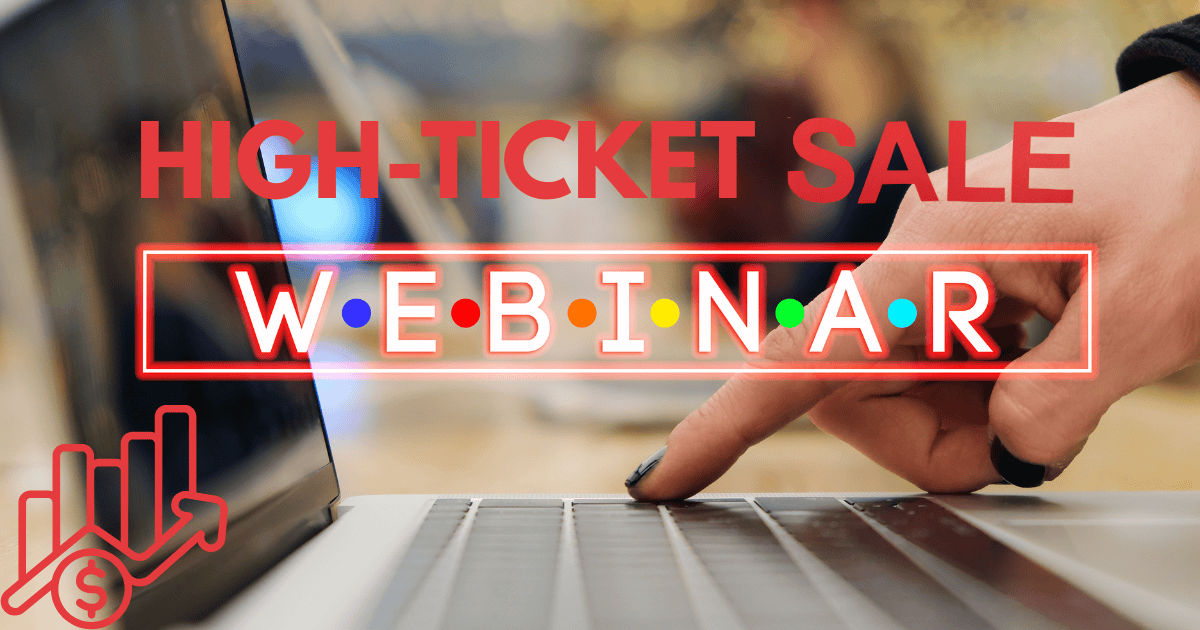
High-ticket sales webinars can transform your business from struggling with low-margin offers to closing deals worth thousands of dollars. While many entrepreneurs spend their time chasing countless small sales, smart business owners use webinars to sell fewer products at significantly higher prices—and make more money in the process.
This comprehensive guide will show you exactly how to create, run, and optimize high-ticket sales webinars that consistently convert prospects into paying customers. You’ll learn the psychology behind successful webinar funnels, discover proven strategies used by top performers, and get actionable steps to launch your first high-ticket webinar campaign.
Whether you’re currently selling low-ticket offers or looking to scale your existing business, this guide contains everything you need to build a profitable webinar-based sales system that works around the clock.
What Are High-Ticket Sales Webinars?
A high-ticket sales webinar is a live or automated online presentation designed to sell products or services priced typically between $1,000 and $50,000 or more. Unlike traditional webinars that focus on lead generation or low-priced product sales, these presentations are strategically crafted to build trust, demonstrate expertise, and guide prospects toward making significant purchasing decisions.
The beauty of high-ticket webinars lies in their ability to compress the entire sales process into a single, focused experience. Instead of requiring multiple touchpoints, sales calls, and follow-up sequences, a well-executed webinar can take a cold prospect and turn them into a customer within 60-90 minutes.
High-ticket coaching programs, consulting services, masterminds, and premium courses represent some of the most common high-ticket sales examples you’ll encounter. These offers require more sophisticated selling approaches than traditional low-cost products because prospects need additional convincing before investing substantial amounts of money.
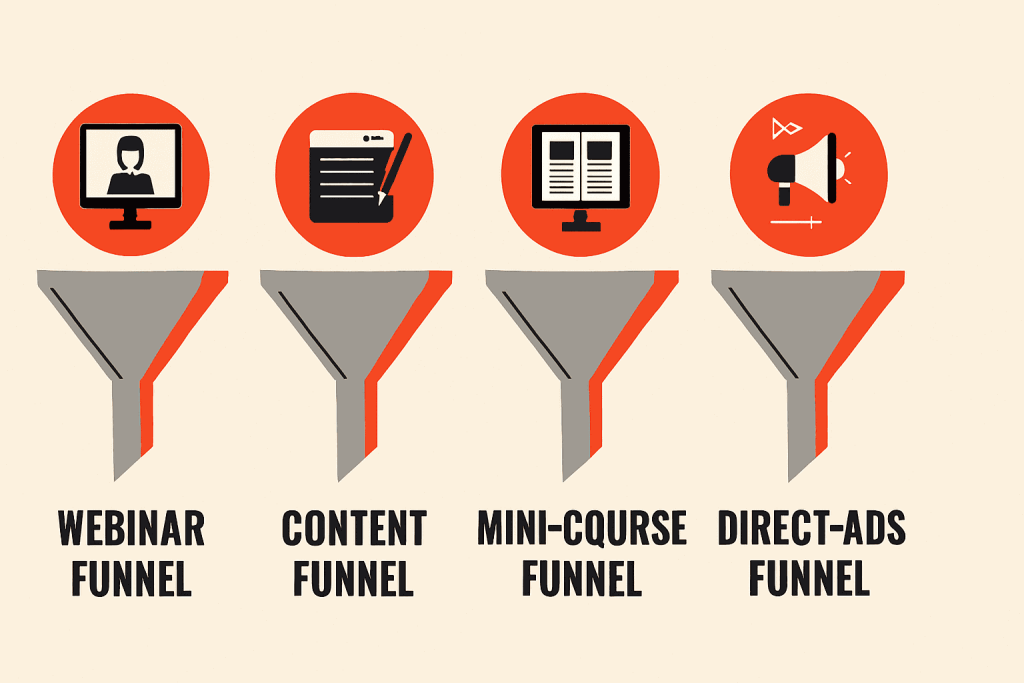
Why Webinars Work for High-Ticket Sales
Building Trust and Authority
High-ticket purchases require significant trust between buyer and seller. Webinars provide an ideal environment to establish this trust by allowing you to demonstrate your expertise over an extended period. When prospects can see and hear you explaining complex concepts, sharing case studies, and answering questions in real-time, they develop confidence in your abilities.
The format naturally positions you as an authority figure. Standing in front of a presentation, teaching valuable content, and guiding the conversation creates a teacher-student dynamic that prospects respect and respond to positively.
Overcoming Price Objections
Price resistance becomes a major barrier when selling expensive products or services. Webinars address this challenge by focusing extensively on value demonstration before revealing pricing. By the time you present your offer, attendees understand exactly what they’re getting and why it’s worth the investment.
The educational format also allows you to reframe pricing discussions. Instead of simply stating your price, you can break down the value components, compare costs to alternatives, and present compelling return-on-investment calculations.
Creating Urgency and Scarcity
Successful high-ticket webinars incorporate urgency and scarcity elements that motivate immediate action. Limited-time bonuses, restricted enrollment periods, and exclusive pricing create compelling reasons for prospects to purchase during or immediately after the presentation.
This urgency becomes particularly effective because attendees have already invested their time in the full presentation. The psychological commitment they’ve made increases their likelihood of taking action when presented with time-sensitive offers.
Essential Components of a High-Ticket Webinar
The Hook and Opening
Your webinar’s first five minutes determine whether prospects stay engaged or click away. Start with a powerful hook that immediately addresses your audience’s biggest pain point or most desired outcome. Share a compelling statistic, tell a relevant story, or make a bold promise that captures attention.
Clearly state what attendees will learn and accomplish during the session. People need to understand the value they’ll receive in exchange for their time investment. Set expectations for the presentation length, interaction opportunities, and what happens at the end.
Value-Driven Content Section
The middle portion of your webinar should deliver substantial educational value. This isn’t the place for surface-level tips or basic information readily available elsewhere. Share advanced strategies, insider insights, or proprietary methods that demonstrate your expertise.
Structure this section around three to five key teaching points that logically flow toward your eventual offer. Each point should provide genuine value while subtly highlighting problems that your product or service solves. The goal is to make prospects think, “If this free content is this valuable, imagine what their paid program contains.”
The Transition and Offer
The transition from content to sales pitch requires careful handling. Many webinar presenters struggle with this shift, either being too abrupt or too subtle. Effective transitions acknowledge the value provided while naturally introducing the logical next step.
Present your offer as the natural solution to problems highlighted during the content section. Avoid making it feel like a bait-and-switch scenario. Instead, position your product or service as the implementation vehicle for the strategies you’ve taught.
Proof and Social Evidence
High-ticket sales require substantial proof that your methods work and your promises are credible. Include detailed case studies showing specific results achieved by previous customers. Share testimonials that address common objections and highlight transformation stories.
Quantifiable results work particularly well for high-ticket offers. Instead of vague success stories, present concrete data showing revenue increases, time savings, or other measurable improvements your customers experienced.
Building an Effective Webinar Funnel
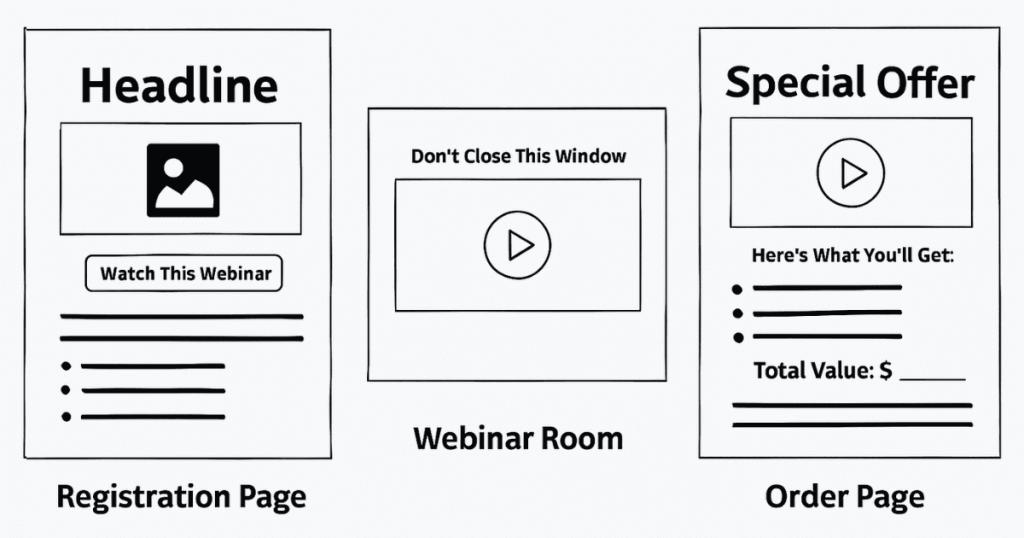
Registration Page Optimization
Your webinar registration page serves as the first conversion point in your sales funnel. The headline should clearly communicate the primary benefit attendees will receive. Focus on outcomes rather than features—people care more about results than processes.
Include bullet points highlighting specific things attendees will learn or achieve. Use social proof elements like registration numbers or testimonials from previous attendees. Keep the registration form simple, typically requesting only name and email address to minimize friction.
Email Sequence Strategy
The email sequence between registration and the live webinar plays a crucial role in attendance rates and sales preparation. Send a confirmation email immediately after registration, followed by reminder emails that build anticipation and provide value.
Share preliminary content that primes prospects for your main presentation. This might include relevant case studies, industry insights, or preparatory materials that enhance the webinar experience. The goal is to maintain engagement while setting expectations for the value they’ll receive.
The Evergreen Webinar Funnel
An Evergreen Webinar Funnel represents the ultimate scalability solution for high-ticket sales. Instead of being limited to specific presentation times, evergreen webinars run automatically, allowing prospects to register and attend on demand while maintaining the urgency and scarcity elements of live presentations.
The key to successful evergreen funnels lies in creating authentic urgency without deceiving prospects. Use enrollment deadlines, bonus expiration dates, or limited availability to create genuine scarcity. Avoid fake countdown timers or dishonest tactics that damage trust and credibility.
Technology platforms like WebinarJam, Demio, or EverWebinar provide tools for creating professional evergreen webinar experiences. These systems handle registration, delivery, and follow-up automatically while providing detailed analytics for optimization.
Follow-Up Sequence
Not everyone who attends your webinar will purchase immediately. A comprehensive follow-up sequence nurtures prospects who need additional convincing or more time to make their decision.
Create email sequences that address common objections, provide additional social proof, and offer different ways to engage with your business. Some prospects might prefer one-on-one consultations, while others respond better to additional automated content.
High-Ticket Sales Examples and Case Studies
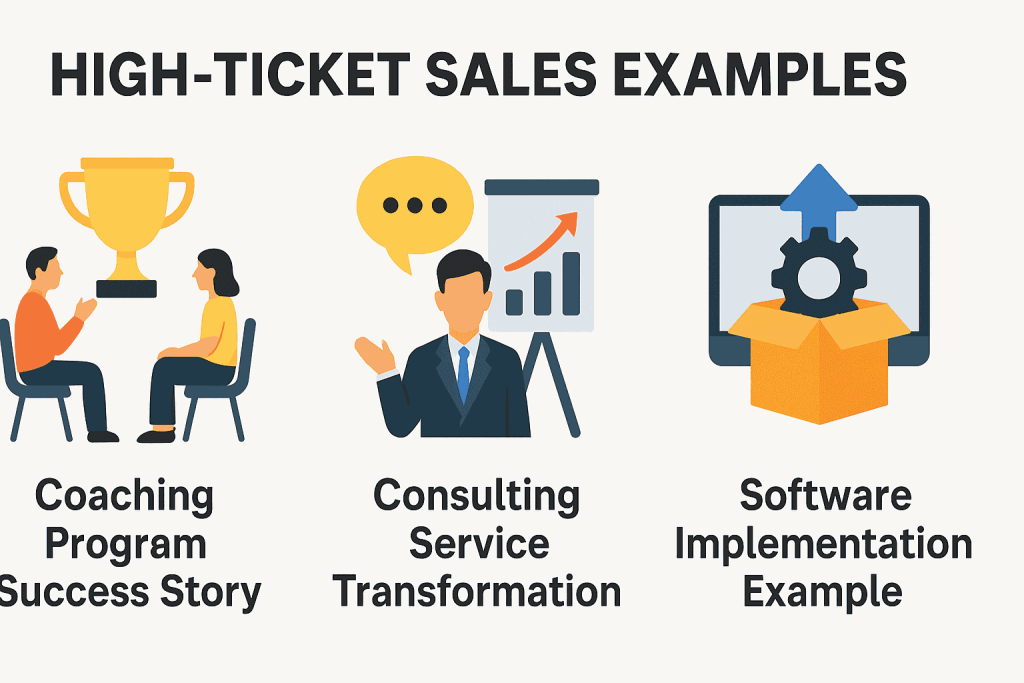
Coaching Program Success Story
A business coach struggling with low ticket offers transformed her revenue by switching to high-ticket sales webinars. Previously selling $97 courses to hundreds of customers, she developed a comprehensive coaching program priced at $5,000 and promoted it through weekly webinars.
Her webinar focused on the three biggest mistakes entrepreneurs make when scaling their businesses. After providing valuable content addressing each mistake, she introduced her six-month coaching program as the solution. By selling just four coaching packages monthly instead of hundreds of low-priced courses, she tripled her revenue while working with fewer, more committed clients.
Consulting Service Transformation
A marketing consultant used webinars to transition from project-based work to retainer agreements. His presentation educated prospects about the hidden costs of inconsistent marketing efforts and demonstrated his proprietary client acquisition system.
Instead of competing on price for individual projects, the webinar positioned his ongoing consulting service as an investment in sustainable growth. He structured his offer as a yearly retainer starting at $10,000, focusing on long-term results rather than short-term tactics.
Software Implementation Example
A software company selling a complex business management platform used webinars to move from self-service sales to high-value implementation packages. Their presentation demonstrated the difference between basic software usage and full strategic implementation.
The webinar showed how most companies achieve minimal results with DIY approaches, while businesses working with their implementation team see dramatic improvements. They offered complete setup and training packages starting at $15,000, positioning these services as essential for success rather than optional add-ons.
Common Mistakes to Avoid
Focusing Too Much on Features
Many high-ticket webinar presentations fall into the trap of over-explaining features instead of emphasizing benefits and outcomes. Prospects don’t care about every detail of your process—they want to understand how your solution will improve their lives or businesses.
Structure your content around desired outcomes and work backward to explain relevant features. Always connect features to specific benefits that matter to your target audience.
Insufficient Value in Content
Attempting to withhold valuable information until after purchase backfires in high-ticket sales scenarios. Prospects expect substantial value from the webinar itself as proof of your expertise and the quality of your paid offerings.
Provide genuinely useful strategies and insights during the content portion. The goal is to make prospects think, “If this free information is this valuable, their paid program must be incredible.”
Weak Call-to-Action
High-ticket sales require strong, clear calls-to-action that guide prospects toward the next step. Vague invitations or multiple options create confusion and reduce conversion rates.
Design a single, compelling call-to-action that makes the next step obvious. Whether it’s scheduling a consultation, joining a program, or making a purchase, remove any ambiguity about what prospects should do next.
Advanced Optimization Strategies
Audience Segmentation
Not all webinar attendees are equally qualified prospects for high-ticket offers. Implement segmentation strategies that identify the most promising leads and customize follow-up approaches accordingly.
Track engagement metrics like attendance time, question submissions, and replay viewing to score prospect quality. Highly engaged prospects receive different follow-up sequences than those who attended briefly or watched replays.
Multi-Webinar Sequences
Some high-ticket offers benefit from a multi-part webinar series that builds value and commitment over time. This approach works particularly well for complex services or high-priced programs where prospects need extensive education before purchasing.
Design each webinar to provide complete value while building toward the next session. Use cliffhangers and exclusive bonuses to maintain attendance throughout the series.
Integration with Sales Teams
For extremely high-ticket offers, webinars work best as lead qualification tools rather than direct sales mechanisms. Use webinars to identify serious prospects who then receive personalized sales consultations.
Train sales teams to reference webinar content during follow-up conversations. This creates continuity and leverages the trust and authority established during the presentation.
Technology and Tools
Webinar Platforms
Choose webinar platforms that support your specific high-ticket sales requirements. Features like automated registration, replay delivery, attendee engagement tools, and integration capabilities impact your funnel’s effectiveness.
Popular platforms include Zoom Webinar for live presentations, WebinarJam for hybrid approaches, and specialized tools like EverWebinar for fully automated evergreen funnels.
Analytics and Tracking
Successful high-ticket webinar funnels require detailed analytics to identify optimization opportunities. Track metrics throughout the entire funnel, from registration rates through final sales conversions.
Key metrics include registration conversion rates, attendance rates, engagement levels, offer acceptance rates, and customer lifetime value. Use this data to continuously improve your presentations and follow-up sequences.
Your Next Steps to High-Ticket Webinar Success
Creating a successful high-ticket sales webinar requires careful planning, compelling content, and systematic optimization. Start by identifying your ideal high-ticket offer and understanding your target audience’s biggest challenges and desired outcomes.
Develop your webinar content around valuable education that naturally leads to your offer. Focus on building trust, demonstrating expertise, and addressing price objections before presenting your solution.
Build a complete webinar funnel that nurtures prospects from registration through purchase and beyond. Test different elements systematically and optimize based on real performance data rather than assumptions.
Remember that high-ticket sales webinars are marathon events, not sprints. Invest time in creating exceptional experiences that serve your prospects while building your business. The effort required is significant, but the revenue potential makes it worthwhile for businesses ready to scale beyond low-ticket offers into premium market segments.




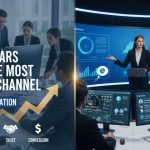
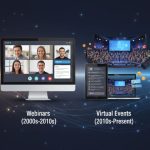
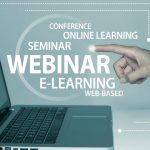












No Comments